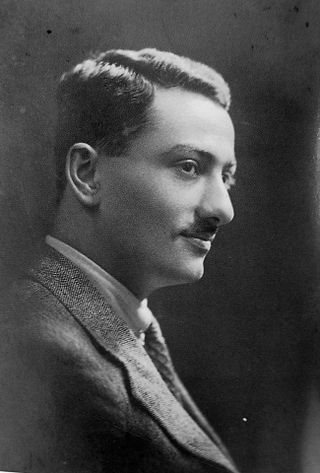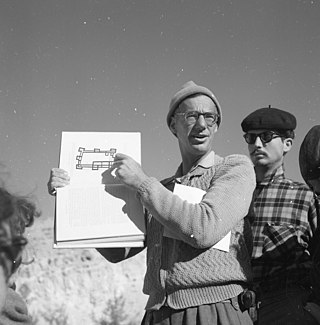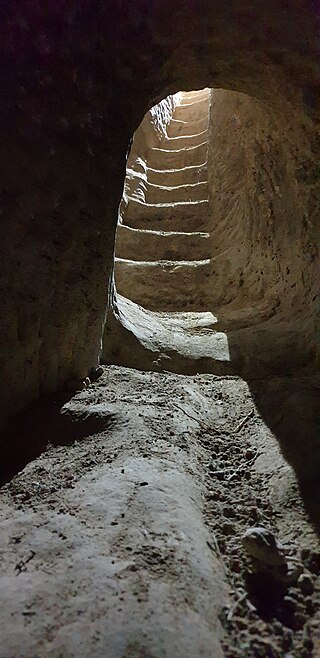
Duo Datz is a group comprising Orna and Moshe Datz. A musical duo in Israel for audiences of all ages, they were also introduced to European audiences by winning a third place for Israel at the 1991 Eurovision Song Contest.

Tell Qasile is an archaeological site near the Yarkon River in Tel Aviv, Israel. Over 3,000 years old, the site contains the remains of a port city founded by the Philistines in the 12th century BC.

Abdel Rahman Zuabi was an Israeli Arab judge. In 1999, he served as an Israeli Supreme Court justice.

The Abraham Avinu Synagogue is a synagogue in the Jewish Quarter of Hebron. Built by Sephardic Jews led by Hakham Malkiel Ashkenazi in 1540, its domed structure represented the physical center of the Jewish Quarter of the Old City of Hebron. The synagogue became the spiritual hub of the Jewish community there and a major center for the study of Kabbalah. It was restored in 1738 and enlarged in 1864; the synagogue stood empty since the 1929 Hebron massacre, was destroyed after 1948, was rebuilt in 1977 and has been open ever since.

Musa Alami Arabic: موسى العلمي, Müsə al-‘Alāmi) was a prominent Palestinian nationalist and politician. Due to Alami having represented Palestine at various Arab conferences, in the 1940s, he was viewed by many as the leader of the Palestinian Arabs.

Komemiyut is an Hasidic moshav in south-central Israel. Located in the southern Shephelah near Kiryat Gat, it falls under the jurisdiction of Shafir Regional Council. In 2022 it had a population of 606.

Kfar Uria is a moshav in central Israel. Located near Beit Shemesh in the Shephelah. It falls under the jurisdiction of Mateh Yehuda Regional Council. In 2022 it had a population of 910.

The Justice Ministry is the Israeli government ministry that oversees the Israeli judicial system.

Yohanan Aharoni was an Israeli archaeologist and historical geographer, chairman of the Department of Near East Studies and chairman of the Institute of Archaeology at Tel-Aviv University.

Horvat Burgin, or Burgin, is an archaeological site in the Judaean Lowlands. Settlement at the site began in the Iron Age. During the Second Temple period, it was a Jewish settlement, which was abandoned in the aftermath of the Bar Kokhba revolt. In the Byzantine period it was populated by Christians, likely including Georgian monks. In the modern period, it was a small Arab hamlet named Khirbat Umm Burj, which was depopulated in 1948.
Manfred Aschner was an Israeli microbiologist and entomologist. Recipient of the Israel Prize in Life Sciences. He was a professor in the Faculty of Biotechnology and Food Engineering at the Technion.

Bank of Jerusalem, Ltd. is Israel's seventh largest bank, with total assets of 9,301 million shekels. Bank of Jerusalem is headquartered in Jerusalem and has 24 branches around the country.

Shmuel Mikunis was a communist Israeli politician and member of the Knesset from 1949 until 1974.

The Bar Kokhba hiding complexes are underground hideout systems built by Jewish rebels and their communities in Judaea and used during the Bar Kokhba revolt against the Roman Empire. The hiding complexes are believed to have played a significant role during the revolt, particularly in Judea proper. Functioning as hiding places during times of emergency, these systems facilitated defense strategies and guerrilla warfare tactics.
The Israel Philatelic Federation is an association whose purpose is to nurture and promote philately in Israel.

Eliyahu Tamler was an Irgun senior commander, who fought in the 1947–1948 civil war in Mandatory Palestine.
Ramathnia is an abandoned village in the center of the Golan Heights, about 10 kilometers east of Katzrin.

Horvat Sumaqa, also spelled Hurvat Sumakah, is an archaeological site in Israel containing the ruins of one of the three largest Jewish settlements south of Mount Carmel during the Roman and Byzantine periods. It is part of the Mount Carmel National Park, south of Daliyat al-Karmel, at an altitude of 350 meters above sea level.
Kiryat Arbaya is an ancient settlement mentioned in two letters written by Simon Bar Kokhba, discovered in the Cave of Letters in Nahal Hever. The settlement has been proposed to be identified with the Arab village of Al-Arroub south of Gush Etzion or with Khirbet Arbaya nearby, close to the road between Bethlehem and Hebron. This area is located between Ein Gedi and Betar, where Bar Kokhba's main camp was likely situated. The literal meaning of the name is 'City of the Arabs' or – what might be more plausible in light of the letter's content – 'City of the Willows'. Additionally, some have suggested identifying Kiryat Arbaya from Bar Kokhba's letters with the legend of the birth of the Messiah that appears in the Jerusalem Talmud and in Lamentations Rabbah.
















